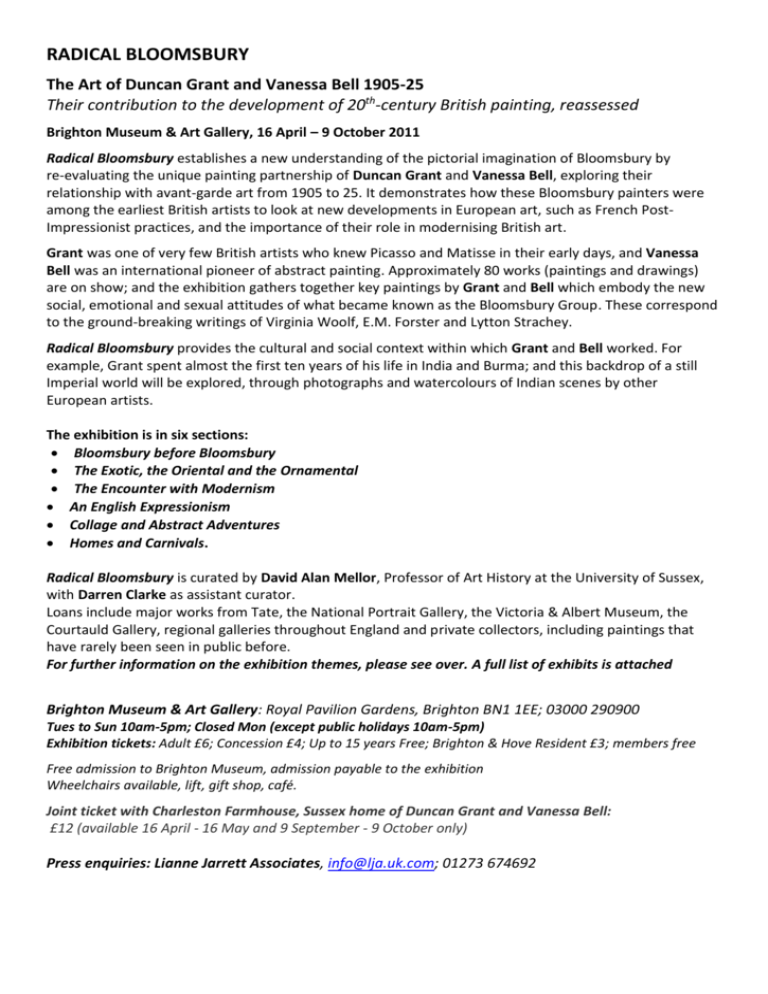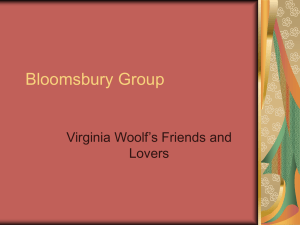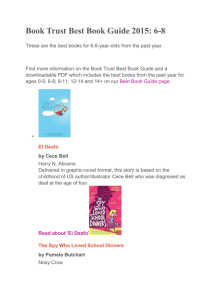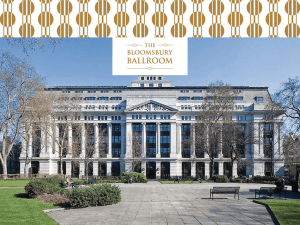Radical Bloomsbury: The Art of Vanessa Bell and
advertisement

RADICAL BLOOMSBURY The Art of Duncan Grant and Vanessa Bell 1905-25 Their contribution to the development of 20th-century British painting, reassessed Brighton Museum & Art Gallery, 16 April – 9 October 2011 Radical Bloomsbury establishes a new understanding of the pictorial imagination of Bloomsbury by re-evaluating the unique painting partnership of Duncan Grant and Vanessa Bell, exploring their relationship with avant-garde art from 1905 to 25. It demonstrates how these Bloomsbury painters were among the earliest British artists to look at new developments in European art, such as French PostImpressionist practices, and the importance of their role in modernising British art. Grant was one of very few British artists who knew Picasso and Matisse in their early days, and Vanessa Bell was an international pioneer of abstract painting. Approximately 80 works (paintings and drawings) are on show; and the exhibition gathers together key paintings by Grant and Bell which embody the new social, emotional and sexual attitudes of what became known as the Bloomsbury Group. These correspond to the ground-breaking writings of Virginia Woolf, E.M. Forster and Lytton Strachey. Radical Bloomsbury provides the cultural and social context within which Grant and Bell worked. For example, Grant spent almost the first ten years of his life in India and Burma; and this backdrop of a still Imperial world will be explored, through photographs and watercolours of Indian scenes by other European artists. The exhibition is in six sections: Bloomsbury before Bloomsbury The Exotic, the Oriental and the Ornamental The Encounter with Modernism An English Expressionism Collage and Abstract Adventures Homes and Carnivals. Radical Bloomsbury is curated by David Alan Mellor, Professor of Art History at the University of Sussex, with Darren Clarke as assistant curator. Loans include major works from Tate, the National Portrait Gallery, the Victoria & Albert Museum, the Courtauld Gallery, regional galleries throughout England and private collectors, including paintings that have rarely been seen in public before. For further information on the exhibition themes, please see over. A full list of exhibits is attached Brighton Museum & Art Gallery: Royal Pavilion Gardens, Brighton BN1 1EE; 03000 290900 Tues to Sun 10am-5pm; Closed Mon (except public holidays 10am-5pm) Exhibition tickets: Adult £6; Concession £4; Up to 15 years Free; Brighton & Hove Resident £3; members free Free admission to Brighton Museum, admission payable to the exhibition Wheelchairs available, lift, gift shop, café. Joint ticket with Charleston Farmhouse, Sussex home of Duncan Grant and Vanessa Bell: £12 (available 16 April - 16 May and 9 September - 9 October only) Press enquiries: Lianne Jarrett Associates, info@lja.uk.com; 01273 674692 RADICAL BLOOMSBURY: the six themes (all pictures mentioned are shown in ‘Radical Bloomsbury’) Key to lenders: (T)= Tate; (C)= Courtauld Institute Bloomsbury before Bloomsbury Grant and Bell’s familiarity with recent pictorial traditions and possibilities, such as French intimiste painting, are explored. Grant exhibited Tulips (Southampton City Art Gallery) in an early Camden Town exhibition. Symboliste painting was another thread in British vanguard art, and Grant’s The Dancers (191011) (T) re-codes Burne-Jones and indicates an interest in Matisse. Grant’s Still life with Peaches (1910) (C) displays elements of various pre-modernist genres and styles, and demonstrates the impact of Cézanne on Grant and Bell’s circle, as well as the influence of Matisse’s c.1900 style. The Exotic, the Oriental and the Ornamental This theme was crucial throughout Grant’s career. Radical Bloomsbury sets The Queen of Sheba (1912) (T) in the context of his photographs of an angular, exotic Nijinsky and Grant’s presence, with Virginia Woolf, in ‘The Dreadnaught Hoax’, dressed in ‘Eastern’ robes, in 1910. A contemporary re-assessment of Byzantine mosaics underpins the style of Grant’s Borough Polytechnic Mural: Bathing (1911) (T), as well as Bloomsbury’s depictions of the male body animated by rhythmic movements. The Encounter with Modernism Radical Bloomsbury shows how Grant and Bell negotiated the changes made by modernist artists in Paris, particularly Matisse and Picasso. This is illustrated by Bell’s Studland Beach (1912) (T), one of the most radical works of that time, and Grant’s painting Tennis Player (1913) (C). The latter shows the body stretched and dynamised by contemporary leisure. Bell’s Adam and Eve screen design (1912) (C) and Grant’s Female Nude and Male Nude, shutter designs for 38 Brunswick Square (1912) (C), are audacious, ‘idyll’ paintings exemplifying what Virginia Woolf called a ‘Neo-Pagan’ outlook, which was embraced by Bloomsbury, Rupert Brooke, the Olivier sisters and others. An English Expressionism An outstanding example of Grant’s scarified ‘woodcut’ style, and interest in primitivism, is Head of Eve (c.1913) (T), which encapsulates the burgeoning interest in tribal art and the growing influence of Picasso. It is a study for the larger masterpiece, Adam and Eve, lost in the Millbank floods which ruined many Tate pictures in the late 1920s. Grant’s The Ass (c.1913) (T), takes Raoul Dufy’s Bestiary as a point of departure, and demonstrates a rawness of approach often missed in accounts of Bloomsbury painting. It was purchased by Roger Fry, as representative of the new taste. Collage and Abstract Adventures Grant’s Abstract Kinetic Painting with Sound (1914) (T) was an unparalleled abstract painting for that historical moment in London. It utilised multi-media approach, engaging with music and time-based kinetic art (shown in Radical Bloomsbury with Tate’s film of it, kineticised). Grant’s Still Life at the Dinner Table (1912) (C) demonstrates his interest in the linear and graphic languages of Cubism, and also references the experiments of the Duchamp-Villon brothers, illustrating the plurality of styles which Grant could employ. Homes and Carnivals Grant’s Venus and Adonis (1921) (T) takes an established myth and renders it as comedy - a genre in which he excelled. This is an example of his interpretation of Picasso’s stylistic innovations, but in a comic mode. Bell’s Still Life at a Window (1922) (C), an urn set against central London rooftops, anticipates Paul Nash’s metropolitan metaphysics.





